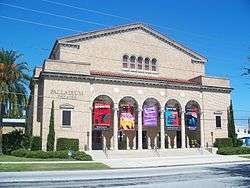Howard Lovewell Cheney
Howard Lovewell Cheney (1889–1969) was an architect and engineer. He designed Washington National Airport and the Miami Beach Post Office (1937).[1] He was a fellow with the American Institute of Architects.

Cheney was born in Chicago, Illinois in 1889. He studied at the Armour Institute of Technology and the University of Illinois.[2] He worked for the Public Buildings Branch of the U.S. Treasury Department from 1934 to 1942; and for the University of Illinois from 1938 to 1940 and again from 1946 to 1948. He designed the Federal Building (Gary, Indiana) as well as Federal Buildings in Peoria, Illinois and New Orleans. He designed the Federal Building and Court of Peace for the 1939 World's Fair. He also designed the original Washington National Airport building and was supervising architect for the construction of the Chicago Tribune Tower in Chicago.[3] He designed the Palladium at St. Petersburg College.
Works
- F. Edward Hebert Federal Building (1939) on Camp Street in New Orleans. Art Deco architecture [4][5]
- C.A. Johnson Residence in Highland Park, Illinois [6]
- Federal Building at the New York World's Fair [6]
- Sixteenth Church of Christ, Scientist[6] in St. Petersburg, Florida at 253 5th Avenue North)
- Unidentified residence with Bernard C. Greengard in Evanston, Illinois[6]
- West Town State Bank in Chicago, Illinois[6]
- Washington National Airport (1940)[7]
- Miami Beach Post Office[8] at 13th Street, north-west corner (1938–39)[9]
- Federal Building and U.S. Courthouse (Peoria, Illinois) (1938), a limestone and granite building in Art Deco architecture / Art Nouveau architecture / Art Moderne architecture. Three stories and 118,000 square-feet. Bas reliefs by Freeman L. Schoolcraft[10]
- Stockyards Post Office on Halsted in Canaryville, Chicago[11]
- U.S. Post Office (Gary, Indiana) (constructed 1936 and abandoned 1970s)[12][13]
References
- Miami Post Office
- "HOWARD LOVEWELL CHENEY Chicago, Architecture, A K E; T B n, Architectural Club ; Freshman Varsity Football (3) : Freshman Varsity Basketball Captain (3) ; Freshman Varsity Track (3) ; Varsity Football Squad (4) ; Var- sity Track (4)"
- Henry Lovewell Cheney City of St. Petersburg
- Post office report $5 billion loss The Associated Press November 15, 2013 (Times Picayune) NOLA.com
- F. Edward Herbert Federal Building Waymarking.com
- "Archival Image & Media Collection". School of the Art Institute of Chicago. Retrieved 2013-11-26.
- The American Airport Geza Szurovy Zenith Imprint, 2003 156 pages
- The New Deal in south Florida: design, policy, and community Archived 2013-12-04 at the Wayback Machine by John A. Stuart, John F. Stack – 2008
- "The Art Deco Home - Arts & Crafts Home". Achome.co.uk. 2013-08-30. Retrieved 2016-07-04.
- Federal Building and U.S. Courthouse – Peoria, IL – Art Deco – Art Nouveau on Waymarking.com Waymarking.com
- Allix, Eric (2008-10-04). "Stockyards Post Office | Stockyards Post Office on Halsted. …". Flickr. Retrieved 2016-07-04.
- admin (2010-09-04). "Abandoned Post Office". American Urbex. Retrieved 2016-07-04.
- Robinson, Kevin (2010-02-19). "In The Shadow of Chicago: US Post Office". Chicagoist. Archived from the original on 2016-05-28. Retrieved 2016-07-04.